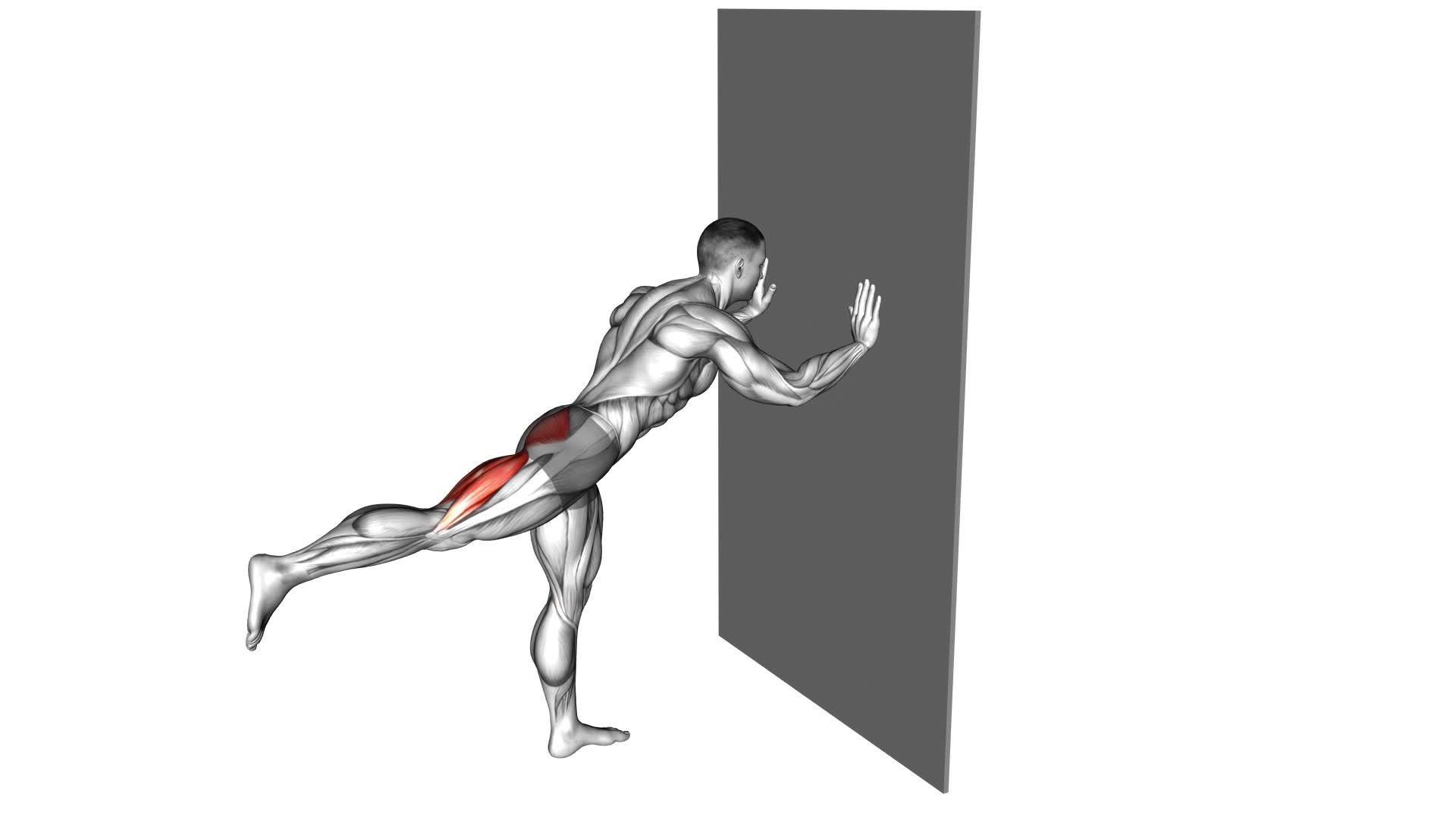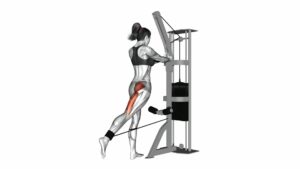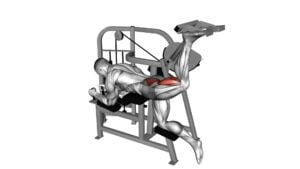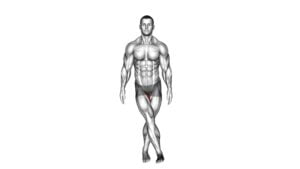Bodyweight Standing Hip Extension (VERSION 2) – Video Exercise Guide & Tips

In this video exercise guide, you'll learn how to perform the bodyweight standing hip extension (version 2) effectively. This exercise targets your glutes, hamstrings, and lower back, helping to improve your overall lower body strength and stability.
Watch This Exercise Video
By following the proper form and avoiding common mistakes, you can maximize the results of this exercise. With modifications and progressions, you can challenge yourself and continually improve.
Get ready to take your bodyweight training to the next level with this dynamic hip extension exercise.
Key Takeaways
- Targets and strengthens glute muscles
- Improves overall lower body strength and stability
- Reduces the risk of injury
- Engages multiple muscle groups simultaneously
Benefits of Bodyweight Standing Hip Extension
One of the main benefits of performing the Bodyweight Standing Hip Extension is that it targets and strengthens your glute muscles.
This exercise is highly effective in activating and engaging the glutes, which play a vital role in stabilizing the hips and lower back. By strengthening the glute muscles, you not only improve your overall lower body strength but also reduce the risk of injury.
Strong glutes help to stabilize the pelvis and protect the knees and lower back from strain and overuse.
Additionally, the Bodyweight Standing Hip Extension is a compound exercise, meaning it works multiple muscle groups simultaneously, allowing you to maximize your results in a shorter amount of time.
This exercise engages not only the glutes but also the hamstrings, quadriceps, and core muscles.
How to Perform Bodyweight Standing Hip Extension
To properly perform the bodyweight standing hip extension, it's important to focus on maintaining proper form and technique. This exercise offers a range of benefits, including muscle activation in the glutes, hamstrings, and lower back.
Proper Form and Technique
To properly perform the Bodyweight Standing Hip Extension exercise, you should begin by standing upright with your feet hip-width apart. This initial body alignment is crucial for maintaining stability throughout the movement. Keep your core engaged and your spine neutral.
To activate the right muscles, shift your body weight onto your left leg and slightly bend your knee. Next, lift your right leg straight back, squeezing your glutes as you extend your hip. Make sure to keep your torso stable and avoid arching your lower back.
Slowly lower your leg back down to the starting position and repeat on the other side. By focusing on proper form and technique, you can maximize muscle activation and minimize the risk of injury.
Benefits and Muscle Activation
To maximize the benefits and muscle activation of the Bodyweight Standing Hip Extension exercise, engage your glutes and maintain stability by focusing on proper form and technique. This exercise primarily targets the gluteus maximus, which is the largest muscle in your buttocks. Additionally, it also engages the hamstrings, quadriceps, and core muscles for stability. By performing this exercise correctly, you can strengthen and tone your glutes, improve hip mobility, and enhance overall lower body strength.
To increase the challenge or modify the exercise, you can use resistance bands around your thighs, or perform the movement on an unstable surface such as a Bosu ball. These variations can help activate different muscle fibers and provide a greater challenge to your glutes and core. Remember to always listen to your body and start with lighter resistance or modifications if needed.
Now that you understand the benefits and muscle activation, let's move on to the next section to learn about common mistakes to avoid in bodyweight standing hip extension.
Common Mistakes to Avoid in Bodyweight Standing Hip Extension
Avoid arching your lower back excessively during the bodyweight standing hip extension exercise. This is one of the common mistakes to avoid in order to prevent injury. Excessive arching of the lower back can put strain on the lumbar spine and lead to discomfort or even pain. To perform the exercise correctly, engage your core muscles and maintain a neutral spine throughout the movement.
Another common mistake is using momentum instead of controlled movements. Swinging your leg back and forth may make the exercise easier, but it reduces the effectiveness and puts unnecessary stress on the hip joint. Focus on using the muscles in your glutes and hamstrings to lift your leg, and control the movement both on the way up and on the way down.
Additionally, avoid leaning too far forward or backward during the exercise. Leaning forward can shift the load to the quadriceps, taking away from the targeted glute and hamstring activation. Leaning backward can put strain on the lower back and diminish the effectiveness of the exercise. Maintain an upright posture throughout the movement to ensure proper muscle activation.
Modifications and Progressions for Bodyweight Standing Hip Extension
Continue to challenge yourself and make progress with the bodyweight standing hip extension exercise by incorporating modifications and progressions. Here are four ways you can modify and progress the exercise to continue challenging your hip muscles and improve your strength and stability:
- Increase the range of motion: Start by performing the standing hip extension with a smaller range of motion and gradually increase it as your strength improves. This can be done by kicking your leg higher behind you or extending it farther to the side.
- Add resistance: Once you have mastered the bodyweight standing hip extension, you can make it more challenging by adding resistance. This can be done by using ankle weights, resistance bands, or holding onto a dumbbell or kettlebell.
- Single-leg variation: To further challenge your hip muscles, try performing the standing hip extension on one leg at a time. This will require more balance and stability, engaging your core and hip muscles even more.
- Plyometric variation: For an advanced progression, you can incorporate plyometric movements into the standing hip extension. This could include performing the exercise with a jump or explosively kicking your leg out to the side or behind you.
By incorporating these modifications and progressions into your bodyweight standing hip extension routine, you can continue to challenge yourself and see improvements in your hip strength and stability.
Now, let's move on to the next section where we'll discuss tips for maximizing results in the bodyweight standing hip extension exercise.
Tips for Maximizing Results in Bodyweight Standing Hip Extension
To maximize your results in the bodyweight standing hip extension exercise, focus on proper form and engage your hip muscles throughout the movement. Proper form and technique are essential for targeting the hip muscles effectively and preventing injury. Here are some tips to help you maximize your results:
- Start by standing tall with your feet hip-width apart and your hands on your hips. Keep your core engaged throughout the exercise.
- As you lift your leg behind you, focus on squeezing your glutes and engaging your hip muscles. This will help you maintain control and stability.
- Keep your standing leg slightly bent to alleviate any strain on your lower back and maintain balance.
- Avoid leaning forward or backward during the movement. Keep your upper body upright and your shoulders aligned with your hips.
- Control the movement by performing it slowly and with control. This will ensure that you're effectively engaging your hip muscles and maximizing the benefits of the exercise.
Safety Precautions for Bodyweight Standing Hip Extension
To ensure your safety during bodyweight standing hip extensions, it's crucial to maintain proper form throughout the exercise. This will help you avoid straining your lower back and reduce the risk of injury.
Remember to follow these injury prevention tips to maximize the effectiveness of the exercise while keeping yourself safe.
Proper Form Importance
Maintaining proper form is crucial for ensuring safety when performing the bodyweight standing hip extension exercise. Here are four injury prevention tips to help you maintain proper form:
- Stand tall with your feet hip-width apart and your core engaged. This will provide a stable base and help protect your lower back.
- Keep your shoulders relaxed and down, away from your ears. Avoid shrugging or tensing them up, as this can lead to unnecessary strain.
- As you extend your leg behind you, focus on squeezing your glutes and keeping your hips square. This will help target the correct muscles and prevent any twisting or imbalance.
- Control the movement throughout the exercise, avoiding any jerking or swinging motions. This will help reduce the risk of strain or injury.
Avoiding Lower Back Strain
To prevent lower back strain while performing the bodyweight standing hip extension exercise, you should focus on maintaining proper alignment and engaging your core. Proper alignment involves standing tall with your feet hip-width apart and your shoulders relaxed. Keep your spine neutral and avoid arching or rounding your lower back.
Engaging your core muscles will help stabilize your pelvis and protect your lower back. Before starting the exercise, take a moment to activate your core by drawing your belly button towards your spine.
Throughout the movement, be mindful of any discomfort or strain in your lower back. If you experience any pain, stop the exercise immediately to prevent injury. Remember to listen to your body and make modifications as needed to avoid strain and promote safety.
Injury Prevention Tips
To prevent injuries during the bodyweight standing hip extension exercise, it's important to focus on maintaining proper form and listening to your body's signals. Here are some injury prevention tips to keep in mind:
- Warm up exercises: Prior to performing the bodyweight standing hip extension, it's crucial to warm up your muscles. Engage in dynamic stretches and movements that target the hip muscles to increase blood flow and prepare your body for the exercise.
- Start with proper technique: Begin the exercise by standing tall with your feet hip-width apart. Keep your core engaged and maintain a neutral spine throughout the movement. Avoid arching your back or leaning forward, as this can strain the lower back.
- Gradually increase intensity: Start with a comfortable range of motion and gradually increase the difficulty of the exercise over time. This allows your muscles to adapt and prevents overexertion or strain.
- Listen to your body: Pay attention to any discomfort or pain during the exercise. If you experience sharp or intense pain, stop immediately and consult a healthcare professional.
Frequently Asked Questions
How Many Sets and Reps Should I Do for Bodyweight Standing Hip Extension?
For optimal results with bodyweight standing hip extension, aim for 2-3 sets of 10-15 reps. This rep range will help target and strengthen your hip muscles effectively.
To progress in this exercise, you can gradually increase the number of reps or sets, or even add resistance by using ankle weights or a resistance band.
Remember to maintain proper form and listen to your body to avoid overexertion.
Can I Do Bodyweight Standing Hip Extension if I Have a Knee Injury?
If you have a knee injury, it's important to be cautious with exercises like the bodyweight standing hip extension. This exercise puts strain on the knees, so it may not be suitable for you.
However, there are modifications and alternatives you can try to target the same muscles without putting as much stress on your knees.
Consult with a healthcare professional or a qualified trainer for guidance on suitable modifications for your knee injury.
Is Bodyweight Standing Hip Extension Effective for Toning the Glute Muscles?
Bodyweight standing hip extension is a great exercise for toning your glute muscles. It targets the glutes, helping to strengthen and shape them.
The exercise involves extending your leg behind you while standing, using your glutes to lift the leg.
This movement can be done in various ways, such as with a resistance band or by adding weights. These variations will increase the intensity and further challenge your glutes, leading to even more toning benefits.
How Long Does It Usually Take to See Results From Bodyweight Standing Hip Extension?
To see results from bodyweight standing hip extension, it usually takes a few weeks of consistent practice. However, it's important to note that everyone's progress may vary.
To maximize your results, avoid common mistakes such as relying solely on momentum and not engaging your glute muscles properly.
To increase the intensity of your workouts, try adding resistance bands or ankle weights, focusing on squeezing your glutes at the top of each movement, and gradually increasing the number of repetitions or sets.
Can I Incorporate Resistance Bands or Weights to Make Bodyweight Standing Hip Extension More Challenging?
Yes, you can definitely incorporate resistance bands or weights to make the bodyweight standing hip extension more challenging. Resistance band modifications can be added by placing the band around your thighs or ankles to increase resistance.
Alternatively, you can use weights such as dumbbells or kettlebells to add extra intensity to the exercise. These modifications will help to further strengthen and tone your hip muscles.
Conclusion
In conclusion, the bodyweight standing hip extension is a beneficial exercise for strengthening the hip muscles.
By following proper form and avoiding common mistakes, you can maximize the effectiveness of this exercise.
Modifications and progressions can be made to suit your fitness level.
Remember to prioritize safety by listening to your body and consulting with a professional if needed.
Incorporating this exercise into your routine can help improve hip strength and overall fitness.

Author
Years ago, the spark of my life’s passion ignited in my mind the moment I stepped into the local gym for the first time. The inaugural bead of perspiration, the initial endeavor, the very first surge of endorphins, and a sense of pride that washed over me post-workout marked the beginning of my deep-seated interest in strength sports, fitness, and sports nutrition. This very curiosity blossomed rapidly into a profound fascination, propelling me to earn a Master’s degree in Physical Education from the Academy of Physical Education in Krakow, followed by a Sports Manager diploma from the Jagiellonian University. My journey of growth led me to gain more specialized qualifications, such as being a certified personal trainer with a focus on sports dietetics, a lifeguard, and an instructor for wellness and corrective gymnastics. Theoretical knowledge paired seamlessly with practical experience, reinforcing my belief that the transformation of individuals under my guidance was also a reflection of my personal growth. This belief holds true even today. Each day, I strive to push the boundaries and explore new realms. These realms gently elevate me to greater heights. The unique combination of passion for my field and the continuous quest for growth fuels my drive to break new ground.







